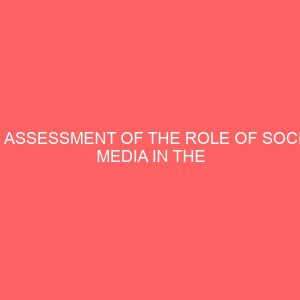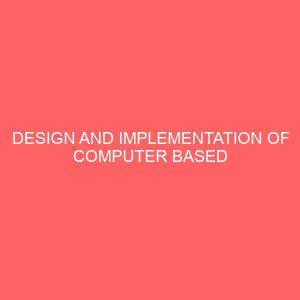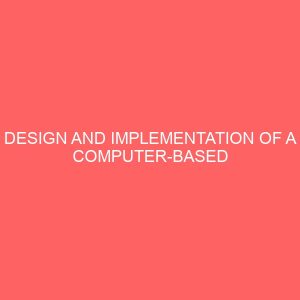Description
CHAPTER ONE INTRODUCTION
A system, with numerous definitions can be literally seen in a computer way as a collection of the hardware and software components of a computer.
According to Stella C. Chiemeke and Franca A. Egbokdara (2006), a system is set of components that interact to achieve a common goal. In another sense, a system is a group of interrelated or intersecting elements forming a unified whole.
A verification system as in this project is an application program used to verify that someone or something rightly and legally belongs to a collection, an organization or an individual. There are different verification system, notably address verification system, adult verification system and card verification system to mention but a few.
Student verification system is used to know whether or not a student is or was a legal and rightly registered student. In this context, it is used to
verify that a student belongs/belonged to an institution and to confirm that he/she is properly registered in a particular department running any of the institutions programme.
This student verification system (SVS), also known as DELSU eVerify is a window based system. It is an electronic and computerized means of verifying someone’s claim of studentship to an institution by means of their matriculation number (Mat No) being input, hence using an output clearly showing the truth or false of his/her claim.
1.1 BACKGROUND OF THE STUDY
In this modern age, computers have verified the cause of their existence. The advent of computers in our society caused a lot of criticism on the danger it poses on the society. Critics of computer and new techniques express their fear on how computers will displace and replace all human skills thus resulting to mass unemployment. The presence of computer on virtually every field of today’s fast life has proved the critic wrong as the invention of computers and new technologies continues to
create additional jobs for those who identify themselves with computers and new technologies. This make computes partner to human beings in any fields of human endeavour.
Over the past decades, students identification and verification has been a major problem in large institutions as documents, certificate and studentship can be forged at a great rate and easy way, using the computer negatively. Forgers fail to know that in this fast moving world, the computer has equally served as an aid to decision making, verification and
authentication.
This is because of computers efficiency in terms of speed, accuracy, reliability, cost and security among others.
In recent years, awareness has existed and created in people as it concerned the use of computer in verifying, authenticating and security activities either through web-based (internet) or window-based. Decision support system (DSS) and others system like management information system (MIS) and information system (IS) are used in organization.
Decisions are largely based on experience and principle. The value of every degree is the reputation of the institution and the students produced, hence, the greatest obstacle to any academic institution which is dishonesty and forgery has to be balanced with verification and authentication systems and processes. “In recent times, effort are bring made to build intelligence into computer system, whereby the computer can be used to process large volume of structural and unstructured information for decision making”.
Said Uzoka, 1998.
1.2 OBJECTIVES OF THE STUDY
The importance of authentic document and certificate can not be overemphasized as the reputations of institution are affected in every counterfeit or forged document or certificate.
To design and implement student verification system for Delta State
University. The system will
Prove the authenticity of document and certificate belonging to Delta State University thereby expunging forged and counterfeit certificate and document from circulation.
Show the valid and legally registered student of Delta State University.
Prove its supremacy over the existing manual system of verification and identification by using dummy data.
To highlight the importance of verifying and authenticating document
and certificates.
1.3 SCOPE OF THE STUDY
The scope and focus of this study is on students’ identification, verification and authentication of document and degrees (certificate) and monitoring of students via the keep of their basic academic information and bio data. Importantly, the student must be students of Delta State University or was a student of Delta State University.
1.4 LIMITATION OF THE STUDY
This study is limited to information gathered from the review of literature and the data collection method used. The proposed system is designed on .NET frame work. Others limitations to the study include:
The implementation and usefulness of the system by Delta State University and other education might not be accepted.
In availability of the system on the internet, thought others user apart from the administrator can use it with some abstraction upon the purchase of the software and installation there in.
Restricted access to some vital and important data and information.
1.5 METHODOLOGY
Software methodology is the set of rules and practices used to create computer software. It is composed of any one of the software development models used together with at least a techniques thus,
METHODOLOGY = SOFTWARE MODEL + TECHNIQUES(S)
An in-depth literature review is done using document review and the internet.
The proposed design will be implemented using MS Visual Studio 2008 tools and Visual Basic as the programming language and MS SQL server 2005 for the database.
The methodology to be adopted for this project is the SSADM (Structured System Analysis and Design Methodology). The SSADM emphasizes on the completing a phase of the software development before proceeding to the next phase and also being able to go back to the other phases in a purely sequential manner. The model used for this project is the
RAD (Rapid Application Development model proposed by IBM (International Business Machine) in 1980 and introduced to software community by James Martins through his book Rapid Application
Development).








Reviews
There are no reviews yet.